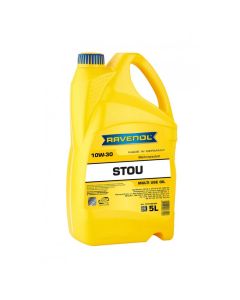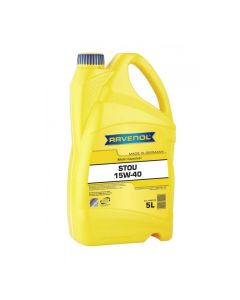10W-30, 15W-40 | Agriculture & Tractor Oils
-
 RAVENOL STOU SAE 10W-30As low as €35.95
RAVENOL STOU SAE 10W-30As low as €35.95- Special oil for agricultural machinery, excavators, construction machinery
- for engine, gearbox, hydraulics, compressors
- fulfills API GL-4, ISO VG 68
-
 RAVENOL STOU SAE 15W-40As low as €36.49
RAVENOL STOU SAE 15W-40As low as €36.49- meets API SF / CE / CF-4 / GL-4
- for Ford, MF, ZF, Allison, John Deere, MB
- CCMC G2/D4 specification
STOU & UTTO - Universal oil for the agricultural area
In the case of lubrication of tractors, it is first necessary to distinguish between the transmission, so if the hydraulics and the engine get a separately or all in one lubrication. In the case of separate lubrication, individual oils can be used. Their requirements and specifications are issued by the same standards as for cars. If a unit lubrication is used, the agricultural machines and tractors usually require a universal oil. This contains it abbreviation STOU which stands for "Super Tractor Oil Universal". It can be used as an oil for engines, shift and power shifts, axle drives and wet brakes as well as for the hydraulic system. In addition, an oil bearing the UTTO, Universal Tractor Transmission Oil designation for shift and power-shift gearboxes, axle drives and wet brakes as well as the hydraulic system are applicable.
Engine oil 10W-30: Large selection, wide range, top prices at ATO24
You are looking for a suitable 10W-30 engine oil for your vehicle? In the online store of ATO24 you are right!
We help you to find out what is important for your vehicle and to buy exactly the right one from our large selection of SAE 10W-30 engine oils. In addition to our competent advice, we offer you attractive prices.
In addition to the engine oil viscosity SAE 10W-40, oils of the viscosity class SAE 10W-30 are among the most demanded engine oils with the cold viscosity 10W. But what exactly does 10W-30 actually mean and why are there so many different oils despite the same viscosity? We will clarify these and other questions in the course of this blog article.
What does 10W-30 mean?
SAE 10W30 is what is known as a multigrade viscosity. Correctly written out as 10W-30, the two viscosity indexes given, 10W and 30, refer to all-season use (suitability for winter and summer use). These multigrade oils were developed over 50 years ago and were intended to replace the procedure of having to change oil at summer and winter time. The viscosity specification in cold (10W) and warm (30) viscosity indicates the flowability of the oil at high and low temperatures.
10W stands for the flowability in winter (this is where the W index comes from). The value 10 is not a directly measurable value of a certain unit but an index number. The lower the number before the W, the better the flowability at cold temperatures and cold starts. A 5W-30 engine oil therefore has better flow properties when cold than a 10W-30 engine oil.
The number 30 stands for the flowability of the oil at a temperature of 100 degrees. Again, the lower the number, the lower the viscosity at a temperature of 100 degrees. Accordingly, a 10w30 engine oil here is comparable to a 5W-30 engine oil.
Buy 10W-30: There is to consider!
Even if the vehicle manual recommends a 10w-30 engine oil, this does not immediately mean that you have found the right 10W30 oil. When buying a 10W-40, attention must be paid to the prescribed specification and approval. They represent the particular chemical properties of an oil.
10W-30 engine oil approvals
As always, your vehicle may require a approval in addition to the 10W-30 viscosity. These approvals are listed on the bottle label next to the specifications. The best known approvals are those of BMW (e.g. LL-04), VW (e.g. VW 507 00) and Mercedes Benz (e.g. MB 251.0). The approvals with the engine oil are comparable with a quality seal of the automobile manufacturers. Thus this manufacturer issues a certain chemical characteristic of oils, which must be fulfilled, in order to be permissible for the cars from the own product series.
What engine oil approvals occur together with viscosity SAE 10W-30? Among many others, common engine oils are of the following clearances and recommendations 10W-30 engine oils:
What is the difference between 10W-30 and 10W-40?
Both viscosities share the "10W" winter property, which means they have the same properties at low temperatures and cold starting. The indices 30 and 40 refer to a difference at high temperatures. Thus, the 10W-40 shows a slightly higher viscosity at high operating temperatures. This difference can be advantageous if the engine has oil losses with a 10W-30 motor oil.
Finde Dein 15W-40 Öl: Viele Marken zu Top Preisen!
"Motorenöl 15W-40" - Du bist auf der Suche nach einem geeigneten Motoröl für Dein Fahrzeug. Eine Vielzahl hochwertiger Öle für Diesel und auch Benzinmotoren findest Du hier zum Kauf in unserem Online Shop.
Durch unser ATO24 Service Team bieten wir Dir kompetente Beratung, wenn Du nicht weiter weißt. Gleichzeitig profitierst Du durch unsere schnelle Logistik von kurzen Lieferzeiten.
Doch was bedeutet eigentlich 15W-40? Wofür ist ein 15W-40 Motoröl geeignet?
Was bedeutet 15W-40 bei Motoröl?
Die SAE Viskositätsklasse 15W40 zeigt Dir an, dass es sich um ein Mehrbereich Motorenöl handelt. Als 15W-40 korrekt ausgeschrieben, verweisen die beiden angegebenen Viskositätsindizes 15W und 40 auf eine Ganzjahreseinsatzzeit (Eignung für Winter- und Sommerzeit). Diese Mehrbereichsöle wurden vor über 50 Jahren entwickelt und sollten das Verfahren ablösen, das Öl zur Sommer- und Winterzeit wechseln zu müssen. Die Viskositätsangabe in Kalt- (15W) und Warmviskosität (40) gibt die Fließfähigkeit des Öles bei hohen und niedrigen Temperaturen an.
15W steht für die Fließfähigkeit im Winter (hierher rürrt der Index W). Bei dem Wert 15 handelt es sich dabei um keinen direkt messbaren Wert einer bestimmten Einheit sondern um eine Indexzahl. Je geringer die Zahl vor dem W, desto besser ist die Fließeigenschaft bei kalten Temperaturen und beim Kaltstart. Ein 5W-40 Motoröl hat demnach im kalten Zustand eine bessere Fließeigenschaft als ein 15W-40 Motoröl.
Die Zahl 40 steht für die Fließfähigkeit des Öles bei einer Temperatur von 100 Grad. Auch hier gilt wieder: Je geringer die Zahl, desto geringer ist die Zähflüssigkeit bei einer Temperatur von 100 Grad. Demnach ist ein 15w40 Motoröl dünnflüssiger als ein 15W-50 Motoröl.
15W-40 kaufen: Das gibt es zu beachten!
Auch wenn das Fahrzeughandbuch ein 15w-40 Motoröl empfiehlt, ist nicht gleich das richtige 15W40 Öl gefunden. Beim Kauf eines 10W-40 muss auf die vorgeschriebenen Spezifikation und Freigabe geachtet werden. Sie stehen für die besonderen chemischen Eigenschaften eines Öles.
15W-40 Motoröl Freigaben
Wie immer kann für Dein Fahrzeug neben der Viskosität 15W-40 auch noch eine Freigabe vorgeschrieben sein. Diese Freigaben sind auf dem Flaschenetikett neben den Spezifikationen aufgelistet. Zu den bekanntesten Freigaben gehören jene von BMW (bspw. LL-04), VW (bspw. VW 507 00) und Mercedes Benz (bspw. MB 251.0). Die Freigaben beim Motoröl sind vergleichbar mit einem Qualitätssiegel der Automobilhersteller. So gibt dieser Hersteller eine bestimmte chemische Eigenschaft von Ölen aus, die erfüllt werden müssen, um zulässig für die Autos aus der eigenen Produktserie zu sein.
Welche Motoröl Freigaben kommen zusammen mit der Viskosität SAE 15W-40 vor? Neben vielen anderen, sind häufig Motorenöle der folgenden Freigaben und Empfehlungen 15W-40 Motorenöle:



